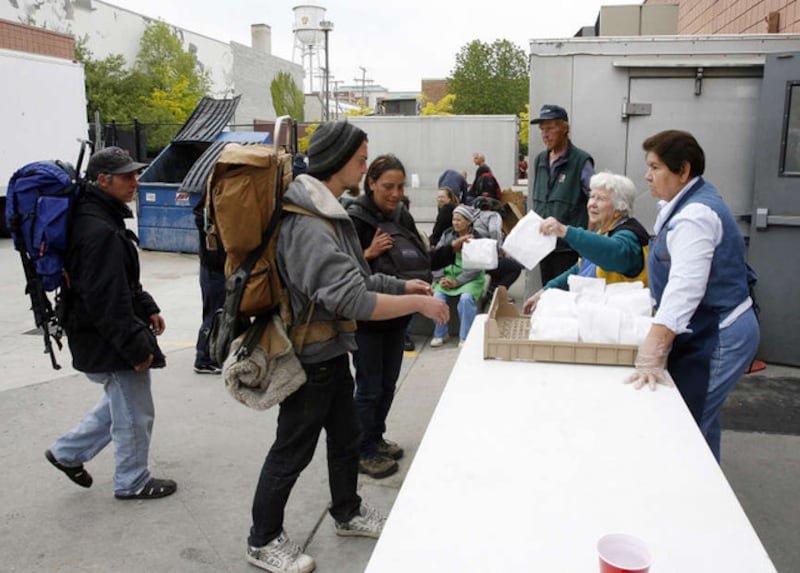Elected officials at the city, county and state levels announced emergency winter overflow shelter efforts and transitional housing plans on Tuesday, as homelessness continues to rise in Salt Lake City and cooler temperatures approach.
Salt Lake County Mayor Jenny Wilson, Salt Lake City Mayor Erin Mendenhall and Utah Homelessness Coordinator Wayne Niederhauser announced plans for approximately 400 beds to come online through a $6 million homelessness housing grant.
The grant is subject to approval by the Salt Lake City Council — which Mendenhall said she wouldn't speak for — but nodded to its presence at the announcement. The grant is intended to bring units into use by April next year, allowing individuals at temporary winter overflow shelters to find transitional or permanent housing.
"This $6 million, if approved by our council, would combine with affordable housing investments already pledged by the state and by Salt Lake County to bolster what we know is needed most, which is permanent housing for people," said Mendenhall.
In addition to the Salt Lake City Homelessness Grant, emerging plans for winter overflow shelters were announced. Emergency winter overflow shelters have become a persistent problem in the state over the years since adopting the dispersed homeless resource center model in 2019 and officials acknowledged that a better system must be developed.
"Since the downtown shelter closed in late 2019, an unintended but painful deficiency in the system has been apparent all along," Mendenhall said. "And increasingly, there are more people in need of a place to call home than there are housing options, or, at many moments in the year, even more spaces than the resource centers can hold."
The dispersed model was meant to alleviate the burden and disperse responsibility among cities throughout Salt Lake County but has resulted in the scrambling of city leaders and other providers to find enough beds before the snow falls.
"Although the practice of opening a winter overflow shelter ... has addressed the deficiency over the winter months, we're all left with the same question every year when those doors close, (about) the temporary space in April. Where are people supposed to go?" Mendenhall added.
City leaders have been criticized in the past for shifting responsibility and failing to provide a plan before winter approaches. Now, those city leaders have no choice but to collaborate and provide a plan to the state, which Niederhauser called 'unprecedented.'
HB440, which passed during the 2022 Utah Legislature, requires cities to come together and submit a plan for summer and winter overflow to the Utah Office of Homeless Services. Failure to submit a plan, or if a plan is insufficient, the state would then have the ability to flex capacity at existing resource centers and use state-owned facilities for overflow.
"No one has ever said, 'The best way to do this is to figure out a couple months before or a few weeks before where we're going to put 100 or 200, 300, 400 people and then hurry up and try to make a place feasible,'" said Mendenhall. "'Make sure it's safe, make sure there's bathrooms, make sure it has fire suppression, and then hurry up and hire appropriate people to staff and keep the place safe.' No one has ever thought that was a good idea. It hasn't been a good idea."
While temporary winter overflow shelter plans are still being discussed and coordinated between city leaders, preliminary plans have designated 65 beds at St. Vincent de Paul; 100 beds at a location to be determined in Millcreek; and approximately 175 beds designated as the "resource center flex."
To reduce homelessness overall, the Salt Lake Valley Coalition to End Homelessness has called for 2,950 units to meet the current need. Those include 600 units of permanent supportive housing, 1,000 units for short-term rapid rehousing assistance, 200 shared housing units, 900 deeply affordable units and 150 permanently subsidized units.
The Utah Legislature allocated $70 million during last year's session to fight affordable housing shortages and homelessness — a sum Niederhauser said may not be enough to reduce homelessness entirely. Of the $70 million, $55 million was allocated directly to the Utah Office of Homelessness which was funneled into a grant program.
The grant process was finished on Friday and Niederhauser announced that by this fall and early next year, there will be 1,780 units of affordable housing available — with 650 of those being deeply affordable and over 500 being dedicated to homelessness.
Additionally, the Utah Office of Homelessness plans to ask the Legislature for $15 million of ongoing funds for additional housing grants.
"Homelessness is a statewide issue and we're addressing on a statewide basis," Niederhauser said. "Each year we're able to put more units on the ground and get more people off the street, out of the shelters and into housing. ... I believe that it's not unreasonable to think that we will have shelters where people stay for a very temporary period of time."

